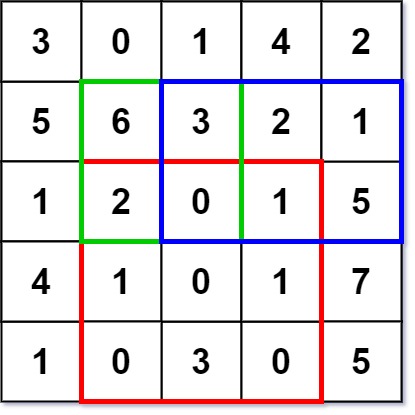Given a 2D matrix matrix, handle multiple queries of the following type:
- Calculate the sum of the elements of
matrixinside the rectangle defined by its upper left corner(row1, col1)and lower right corner(row2, col2).
Implement the NumMatrix class:
NumMatrix(int[][] matrix)Initializes the object with the integer matrixmatrix.int sumRegion(int row1, int col1, int row2, int col2)Returns the sum of the elements ofmatrixinside the rectangle defined by its upper left corner(row1, col1)and lower right corner(row2, col2).
You must design an algorithm where sumRegion works on O(1) time complexity.
Example 1:
Input ["NumMatrix", "sumRegion", "sumRegion", "sumRegion"] [[[[3, 0, 1, 4, 2], [5, 6, 3, 2, 1], [1, 2, 0, 1, 5], [4, 1, 0, 1, 7], [1, 0, 3, 0, 5]]], [2, 1, 4, 3], [1, 1, 2, 2], [1, 2, 2, 4]] Output [null, 8, 11, 12]Explanation NumMatrix numMatrix = new NumMatrix([[3, 0, 1, 4, 2], [5, 6, 3, 2, 1], [1, 2, 0, 1, 5], [4, 1, 0, 1, 7], [1, 0, 3, 0, 5]]); numMatrix.sumRegion(2, 1, 4, 3); // return 8 (i.e sum of the red rectangle) numMatrix.sumRegion(1, 1, 2, 2); // return 11 (i.e sum of the green rectangle) numMatrix.sumRegion(1, 2, 2, 4); // return 12 (i.e sum of the blue rectangle)
Constraints:
m == matrix.lengthn == matrix[i].length1 <= m, n <= 200-104 <= matrix[i][j] <= 1040 <= row1 <= row2 < m0 <= col1 <= col2 < n- At most
104calls will be made tosumRegion.
Companies: Facebook, Lyft, Amazon, Google, Nvidia, Samsung, Uber, Snowflake
Related Topics:
Array, Design, Matrix, Prefix Sum
Similar Questions:
// OJ: https://leetcode.com/problems/range-sum-query-2d-immutable
// Author: github.com/lzl124631x
// Time:
// NumMatrix: O(MN)
// sumRegion: O(1)
// Space: O(MN)
class NumMatrix {
vector<vector<int>> sum;
public:
NumMatrix(vector<vector<int>>& A) {
int M = A.size(), N = A[0].size();
sum.assign(M + 1, vector<int>(N + 1));
for (int i = 0; i < M; ++i) {
int s = 0;
for (int j = 0; j < N; ++j) {
s += A[i][j];
sum[i + 1][j + 1] = s + sum[i][j + 1];
}
}
}
int sumRegion(int row1, int col1, int row2, int col2) {
return sum[row2 + 1][col2 + 1] - sum[row1][col2 + 1] - sum[row2 + 1][col1] + sum[row1][col1];
}
};